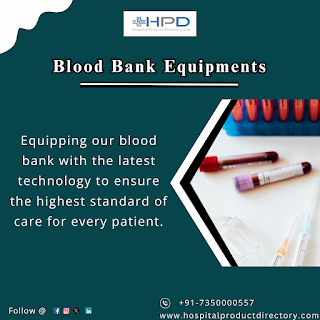Essential Blood Bank Equipment for Saving Lives
Blood banks play a critical role in healthcare by
collecting, testing, processing, and storing blood and blood components for
transfusions. To carry out these vital functions, blood banks rely on
specialized equipment designed to maintain the integrity and safety of the
blood supply.
One of the most important pieces of equipment is the blood collection mixer or scale. These devices provide essential information about the volume of blood being collected, which is crucial for ensuring the proper anticoagulant-to-blood ratio. Other essential collection equipment includes phlebotomy chairs, tourniquets, and blood bag holders.
After collection, the whole blood is separated into its key
components - red blood cells, plasma, platelets, and cryoprecipitate - through
a process called blood component manufacturing. This is done primarily through
centrifugation, which requires specialized blood component separators and
plasma extractors.
To maintain the quality and viability of these blood
components, they must be stored under precise temperature and environmental
conditions. This is where blood bank refrigerators, freezers, and plasma
thawing baths come into play. These units are designed to protect blood from
degradation by precisely controlling temperature, humidity, and air
circulation.
Beyond storage, blood banks also need equipment for safely
transporting blood and components to healthcare facilities. Insulated blood
transport containers and mobile coolers help maintain the cold chain and
prevent spoilage during transit.
The blood banking industry is highly regulated, so
compliance with safety standards is paramount. Blood bank equipment
manufacturers must adhere to strict guidelines for materials, construction, and
performance. Many leading suppliers, such as Naugramedical in India and China,
have built strong reputations for delivering high-quality, compliant devices.
These manufacturers also play a key role in serving the
unique needs of each blood bank. "Blood
bank equipment requires a tailored approach," explains an industry
expert. "Each blood bank has its own processes and space requirements, so
there is no one-size-fits-all solution." Manufacturers work closely with
blood banks to specify the right refrigerators, freezers, agitators, and other
equipment for their particular operations.
In addition to core processing and storage equipment, blood
banks also rely on a range of other specialized instruments. These include
blood bag tube sealers, platelet incubators, microscopes, and waste segregation
materials - all of which play a role in ensuring the safety and efficacy of the
blood supply.
As medical technology continues to advance, we can expect to
see further innovations in blood banking equipment. Emerging technologies like
blood bank information systems and automated component separation are poised to
enhance efficiency and traceability.
Advancements in cryopreservation may also enable longer-term storage of
red blood cells and other components.
Ultimately, the success of any blood bank hinges on the
quality and reliability of its equipment. By partnering with reputable
manufacturers, blood banks can acquire the specialized tools needed to collect,
process, and preserve this precious resource - saving countless lives in the
process.




Comments
Post a Comment